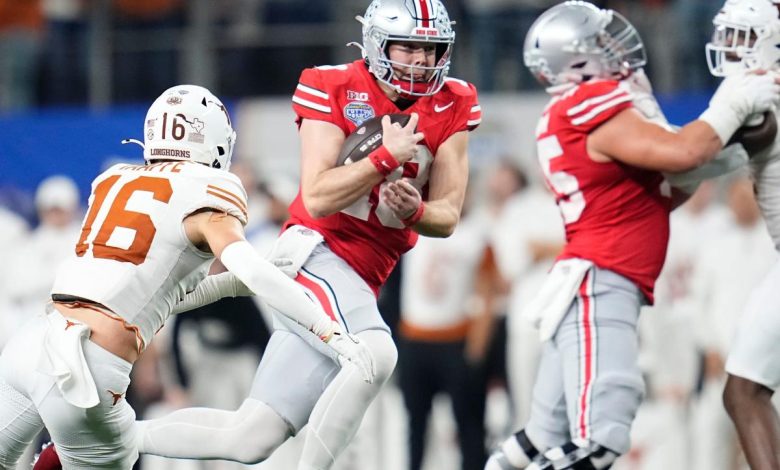Ohio State sports reports a $37.7 million deficit and $292.3 million in operational expenses for 2024.

In an era of rising costs, intensifying competition, and ever-expanding budgets in college sports, Ohio State University’s sports program is facing financial headwinds that are difficult to ignore. According to the latest reports, Ohio State athletics is projecting a deficit of $37.7 million for the 2024 fiscal year, alongside operational expenses that total a staggering $292.3 million. These figures, released by the university, are causing significant concern both within the Buckeyes’ athletic department and across the broader collegiate athletics landscape.
As one of the most successful and recognizable athletic programs in the country, Ohio State University’s financial challenges are surprising given the school’s consistent performance in various sports, particularly football, basketball, and wrestling. With a historically dominant football team, a loyal fanbase, and an expanding media rights portfolio, it might seem as though Ohio State would be immune to financial difficulties. However, as the numbers show, the financial model of collegiate sports—especially at elite programs—has become increasingly strained, and Ohio State’s situation is a reflection of broader trends across the industry.
This article will explore the primary factors behind Ohio State’s deficit, the challenges they face, and the potential solutions the university could pursue to balance their financials while maintaining a competitive edge in collegiate athletics.
The Scope of Ohio State’s Financial Situation
To understand the significance of Ohio State’s reported deficit, it is important to break down the details of the figures. The $37.7 million deficit represents the shortfall between the projected revenue and operational expenses for the athletic department in 2024. The operational expenses for Ohio State athletics are expected to total $292.3 million, a significant increase from previous years, reflecting the rising costs of maintaining and expanding athletic programs.
Ohio State’s expenses span across a wide range of categories:
- Coaching salaries: The Buckeyes have some of the highest-paid coaches in college sports, with head football coach Ryan Day and other prominent coaches commanding top salaries. The growing salaries of coaching staff, both head coaches and assistants, contribute significantly to the overall operational costs.
- Scholarships: With a large number of student-athletes, Ohio State’s commitment to scholarships is a major financial burden. Providing full scholarships for both male and female athletes across multiple sports is a key component of the budget, as it helps maintain the school’s competitive edge in recruiting top talent.
- Facilities and Maintenance: Ohio State’s facilities are world-class, with the football team’s home at Ohio Stadium (often referred to as “The Horseshoe”) being one of the largest and most iconic in the country. The costs of maintaining such facilities, as well as upgrades to stadiums, training rooms, and other athletic venues, are substantial.
- Travel and Logistics: Travel expenses for road games, recruiting trips, and team events contribute heavily to operational costs, especially as the scope of college athletics expands to include national and international competitions.
- Media Rights and Marketing: While media deals, including television rights, are a significant source of revenue for major athletic programs, the cost of marketing, sponsorship deals, and maintaining media contracts also adds to the financial load. In some cases, media rights deals and partnerships are structured in ways that benefit certain sports or programs more than others, creating disparities in revenue generation within an athletic department.
With these factors contributing to operational expenses, Ohio State’s financial structure relies heavily on revenue from ticket sales, media rights, sponsorships, donations, and merchandise sales. However, when these revenue streams do not meet expectations or when costs unexpectedly rise, as they have in the case of Ohio State’s 2024 projections, deficits like the $37.7 million become a significant issue that must be addressed.
The Financial Landscape of College Athletics
The Ohio State situation is not unique; it mirrors the broader financial realities facing college athletics, particularly at the Power 5 level. Over the past several years, athletic departments across the country have been grappling with similar financial challenges. Rising operational costs, particularly in football and basketball, have placed a strain on many programs. Here are some of the primary factors influencing the broader financial landscape of college sports:
1. The Escalating Cost of Coaches and Staff
The salaries of head coaches and assistant coaches have been increasing at an unprecedented rate, driven by competition among elite programs for top-tier talent. As coaches’ salaries rise, so too do the salaries of their support staff, analysts, and trainers. Ohio State, like other Power 5 schools, has been caught in this cycle. Head football coach Ryan Day’s salary, which is among the highest in the country, is a major financial commitment for the university. When you factor in the salaries of his assistants and other support staff, the financial burden becomes clear.
2. The Expansion of Facilities and Infrastructure
As college sports continue to grow in stature and prestige, the demand for state-of-the-art facilities increases. Ohio State has invested heavily in its athletic infrastructure, including upgrades to Ohio Stadium, the Schottenstein Center (home to basketball), and the Woody Hayes Athletic Center (football training facility). While these investments improve the overall competitiveness and appeal of the program, they also lead to higher maintenance costs and debt obligations.
The arms race of facility upgrades—designed to attract recruits, improve player performance, and enhance the fan experience—has put pressure on athletic departments to keep up with the competition.
3. The Impact of the COVID-19 Pandemic
The financial fallout from the COVID-19 pandemic continues to reverberate across college sports. While Ohio State, like many other programs, was able to weather the storm through revenue from television deals and federal aid, the loss of ticket sales and game-day revenues during the pandemic still had a lasting impact. The cancellation or reduction of in-person attendance at games, particularly for football and basketball, led to a significant loss in revenue.
Furthermore, the pandemic caused a shift in the financial landscape for many programs, with a greater emphasis on ensuring financial stability during uncertain times. This led some programs, including Ohio State, to reevaluate their financial strategies and prioritize long-term sustainability.
4. The Changing Media Rights Landscape
Media rights deals are a primary revenue source for college athletic programs, particularly those in major conferences. Ohio State benefits from significant revenue generated by the Big Ten’s media contracts, including those with ESPN and FOX. However, as television and streaming rights continue to evolve, schools must adapt to shifting revenue models. While deals like the one signed by the Big Ten with CBS, FOX, and NBC provide substantial payouts, the distribution of this revenue can vary, and schools may not always see the financial returns that they expect.
Furthermore, Ohio State’s athletic program, like many others, faces challenges related to the evolving landscape of digital media, with younger generations increasingly moving away from traditional cable and toward streaming services. This shift could affect the university’s ability to generate revenue from television deals in the future.
5. NIL and Transfer Portal Effects
The rise of Name, Image, and Likeness (NIL) compensation for athletes and the increased use of the transfer portal are creating additional financial pressures. While NIL provides athletes with opportunities for compensation, it also creates competition among schools to offer lucrative deals to top players, often driving up costs. Ohio State, as a premier program, is likely involved in this competition, and the need to maintain a competitive edge in recruiting can place financial strain on the athletic department.
Moreover, the transfer portal has made it more challenging for schools to maintain stable rosters, leading to increased costs related to recruitment, retention, and scholarship allocations.
Addressing Ohio State’s $37.7 Million Deficit
Given the complex nature of the financial challenges facing Ohio State’s athletic department, addressing the $37.7 million deficit will require a multi-faceted approach. Here are some potential strategies the university could consider to rectify its financial situation:
1. Increase Revenue from Ticket Sales and Donations
One of the primary ways Ohio State could address its deficit is by boosting revenue through ticket sales, particularly for high-demand sports like football and basketball. With a loyal fanbase and strong attendance figures, the university could explore pricing adjustments or new revenue-generating events (e.g., neutral-site games, exhibitions, or special fan events) to generate more money. Additionally, increased fundraising efforts and alumni donations could help offset operational expenses, particularly if Ohio State can connect with its extensive network of former student-athletes and boosters.
2. Efficiency in Operational Spending
In light of rising costs, Ohio State may need to reevaluate its operational spending. This could involve finding ways to cut costs in areas such as travel, recruitment, or marketing. For example, exploring more efficient travel logistics, optimizing the use of facilities, and renegotiating certain contracts could help lower expenses without sacrificing the quality of the athletic programs.
3. Leverage Media and Sponsorship Deals
The university should continue to leverage its media rights deals and sponsorships to generate more revenue. Expanding digital content offerings, exploring new media platforms, and partnering with companies in innovative ways could help diversify income streams. Additionally, Ohio State could seek more lucrative sponsorship agreements to offset the rising costs of maintaining athletic programs.
4. Sustainability and Long-Term Planning
Finally, Ohio State’s athletic department could benefit from creating a long-term financial sustainability plan that accounts for the changing landscape of college sports. This plan would need to consider factors like NIL, shifting media consumption habits, and the potential impact of future economic downturns.









